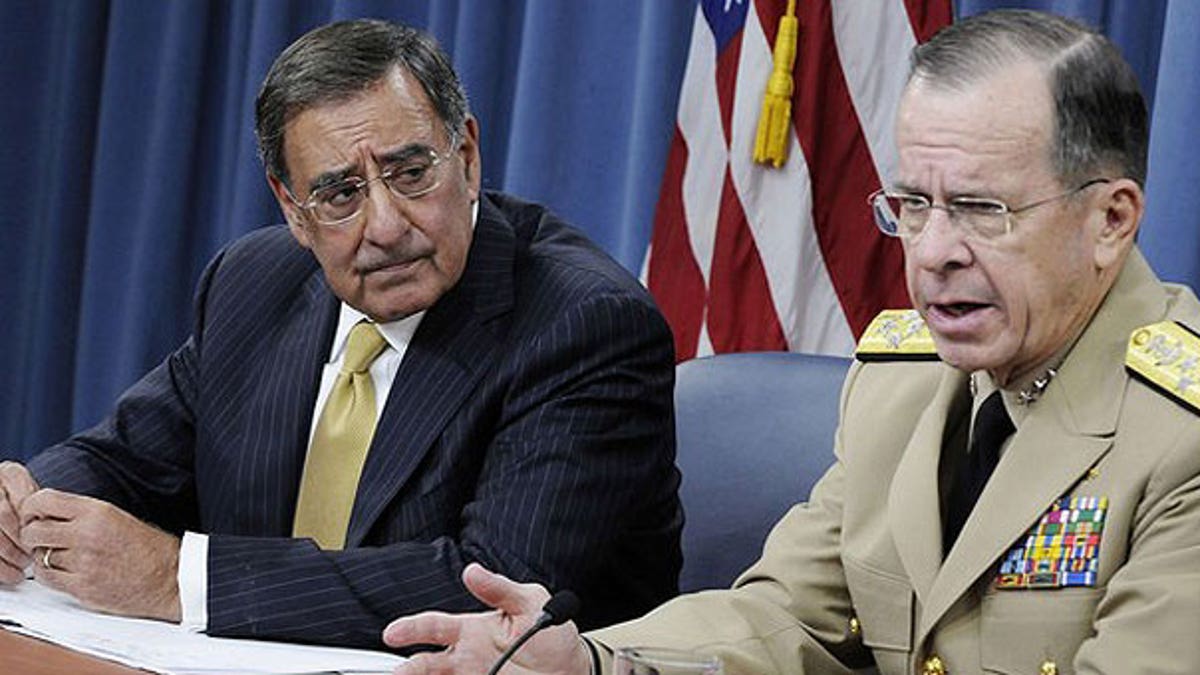
August 4: U.S. Defense Secretary Leon Panetta and Chairman of the Joint Chiefs of Staff U.S. Navy Admiral Michael Mullen hold their first joint news conference at the Pentagon in Washington, D.C. (Reuters)
WASHINGTON -- The Pentagon got nearly everything it asked for during a decade of two wars shadowed by the Sept. 11 terror attacks and the rise of Al Qaeda. No more.
It's a reality that new Defense Secretary Leon Panetta acknowledged Thursday, saying he "recognizes the Department of Defense has to do its part" to meet the public clamor for spending cuts.
Reflecting the widespread demand for fiscal austerity, the compromise debt deal struck by President Obama and congressional leaders this week will slice $350 billion from projected military spending over the next 10 years, and it leaves open the possibility of up to $500 billion in additional reductions.
The prospect of nearly $1 trillion in cuts unnerves military leaders, troubles members of Congress protective of the Pentagon and has touched off a scramble in the defense industry as contractors look to spare their multibillion-dollar weapons programs.
Among the things that could be on the block: A troubled new jet fighter, expensive plans to modernize the nation's nuclear arsenal and perhaps some of the gold-plated benefits now guaranteed to military retirees.
In his first Pentagon news conference, Panetta described a reduction of the magnitude of nearly $1 trillion as "doomsday" and said it would mean "dangerous across-the-board defense cuts that would do real damage to our security, our troops and their families and our ability to protect the nation." The former budget chief in the Clinton administration called the cuts "completely unacceptable" and vowed to fight them.
"People expect the military to provide for our security," Panetta told reporters.
In sounding an alarm, Panetta is pressuring Democrats and Republicans to consider making concessions on their core priorities -- entitlement programs such as Medicare and Social Security defended by Democrats, and increases in taxes resisted by Republicans -- before taking a knife to defense.
Adm. Mike Mullen, the chairman of the Joint Chiefs of Staff, sat side-by-side with Panetta at the Pentagon, and pointed out that the military has a crowded must-do list: wars in Iraq and Afghanistan, support for the NATO-led operation in Libya, disaster relief missions in Haiti and Japan and defense of national interests.
"Debilitating and capricious cuts nearly double to those already in the offing," Mullen warned, would put "at grave risk not only our ability to accomplish the missions we have been assigned, but those we have yet to be assigned as well," Mullen said.
Army Gen. Martin Dempsey, the next chairman of the Joint Chiefs of Staff, recently told Congress that cuts of $800 billion or more "would be extraordinarily difficult and very high-risk."
Defense budgets, not including the costs of the wars in Iraq and Afghanistan, have jumped since 9/11, from just over $370 billion in the late 1990s to around $550 billion today. In the political clamor to slash the deficit, Obama this past spring called for $400 billion in defense cuts over 12 years and former Defense Secretary Robert Gates launched a comprehensive review of the military's strategy and capabilities.
That review could be completed by the end of the summer.
Setting the agenda now is the debt-limit deal to cut more than $2 trillion from federal spending over a decade.
In the initial phase, all security spending -- money for defense, homeland security, veterans, foreign aid and intelligence -- would be cut from the current level of $687 billion this year to $683 billion in next year's budget. Defense would take a share of that $4 billion reduction.
The next step is the unknown that Panetta fears: A 12-member, House-Senate committee must propose up to $1.5 trillion more in cuts over a decade and do so by Nov. 23. If the committee deadlocks or if Congress rejects its recommendations, the Obama administration would be required to impose automatic, across-the-board spending cuts of up to $1.2 trillion, with half coming from defense.
"Clearly we don't want to get to the point ... it's going to be bloody," said Rep. Mike Coffman, R-Colo., a member of the House Armed Services Committee.
The budget proposals provide no specifics, but several programs are often mentioned as possible targets.
Ten years in, the F-35 Joint Strike Fighter, a multibillion-dollar aircraft, has been plagued by cost overruns and delays. The cost of buying more than 2,400 of the next-generation aircraft for the Air Force, Navy and Marine Corps has jumped from $233 billion to $385 billion. Recent estimates say the entire program could exceed $1 trillion over 50 years.
Another potential target is the Medium Extended Air Defense System (MEADS), a multinational missile defense program with Italy and Germany. The Pentagon said earlier this year it would not implement the program, though research will continue for another two years at a cost of more than $800 million. Among the other targets are the numbers of ships and submarines the Pentagon buys.
One of the most costly programs for the Defense Department is its health care coverage for some 10 million active duty personnel, retirees, reservists and their families. The cost has jumped from $19 billion in 2001 to $53 billion.
Obama proposed increasing the fees for working-age retirees in the decades-old health program, known as TRICARE, but has encountered resistance from lawmakers and various associations for military retirees.
Debt-limit negotiators looked at changes in the program for possible savings, and the special bipartisan committee is likely to consider the program in its calculations.




